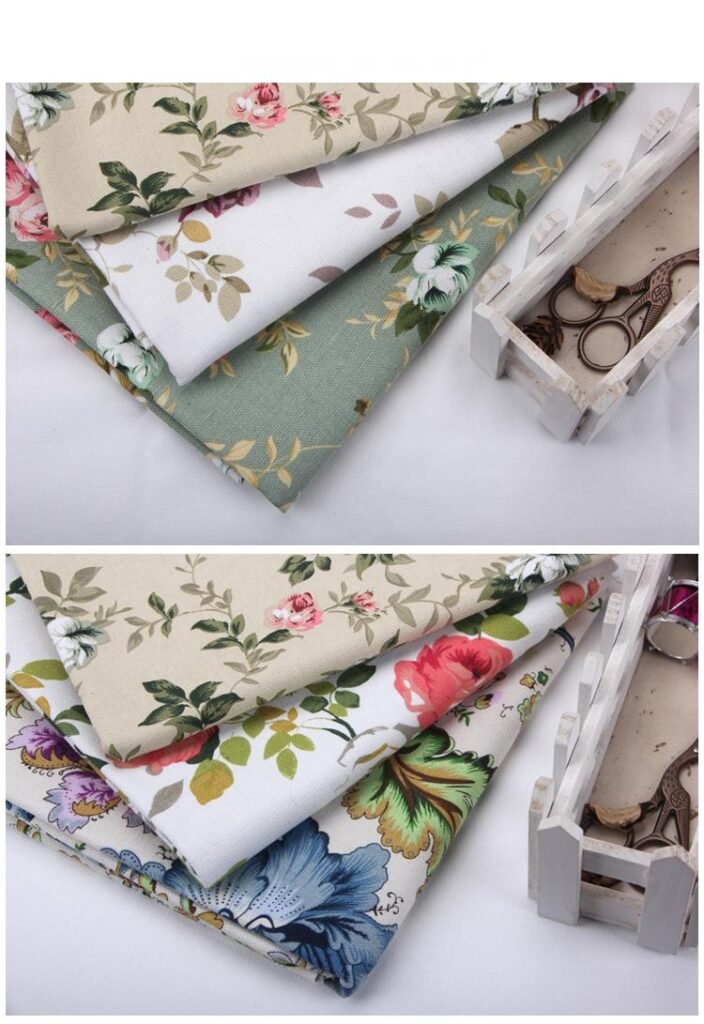
Canvas has carried explorers across oceans, artists into galleries, and industrialists through decades of heavy use. This rugged fabric began its journey as simple hemp sailcloth, evolving into today’s high-performance cottons, polyesters, and hybrid blends. Canvas is traditionally woven from durable natural fibers like cotton or flax, prized for strength and breathability, but modern mills increasingly employ polyester and blended yarns to enhance tear resistance, moisture management, and UV stability. Stick around—later, we’ll peek into an old Venetian sailmaker’s workshop to uncover how centuries-old techniques still shape today’s advanced canvases.
What Are the Historical Origins of Canvas and Its Traditional Fiber Sources?
Canvas originated in the Mediterranean, where sturdy hemp cloth protected wooden hulls and caught favorable winds. Early canvases—made primarily of hemp and flax—offered exceptional tensile strength (up to 4,000 N in 17th-century samples) and weather resistance. As cotton cultivation expanded in the 19th century, cotton replaced hemp in many regions due to its softer hand and easier dye uptake. These natural fibers laid the groundwork for canvas’s reputation as the go-to material for sails, tents, and art canvases.
Tracing Canvas Through Time
A. Hemp and Flax Sailcloth
- Detail: Hemp fibers average 6–9 cm in length, with breaking strengths of 800–1,200 MPa.
- Advantage: Naturally resistant to rot and saltwater—critical for medieval navies.
B. Transition to Cotton Canvas
- Metric: 19th-century cotton canvas weighed 10–12 oz/yd² with thread counts around 8×8 per inch.
- Benefit: Lighter and more flexible than hemp, enabling easier handling and color applications for banners and tents.
C. Early Industrial Weaving Innovations
- Innovation: Introduction of power looms in the 1800s increased production from 20 yards/day to over 200 yards/day.
- Impact: Widespread availability lowered costs, expanding canvas use into awnings, upholstery, and protective covers.
D. Preservation of Traditional Techniques
- Practice: Some artisan mills still hand-loom small batches for specialty art canvases—valued for grain and archival quality.
- Significance: These heritage fabrics command premium prices (up to \$15/yd) but maintain irreplaceable characteristics prized by fine artists.
Comparative Properties of Traditional Fibers
| Fiber Type | Average Fiber Length | Tensile Strength (MPa) | Moisture Regain (%) | Rot Resistance | Typical Canvas Weight (oz/yd²) |
|---|---|---|---|---|---|
| Hemp | 6–12 cm | 800–1,200 | 12.5 | High | 14–18 |
| Flax | 2.5–5 cm | 600–800 | 12 | Moderate | 12–16 |
| Cotton | 2–4 cm | 400–600 | 8.5 | Low | 10–14 |
Critical Perspectives
- Hemp vs. Flax for Art vs. Marine Use Hemp’s higher strength suits maritime needs, whereas flax’s smoother finish excels for painting surfaces.
- Cotton’s Environmental Trade-Offs While cotton is softer and easier to dye, it requires more water (≈10,000 L/kg) and pesticides, influencing sustainability discussions.
- Heritage vs. Efficiency Hand-loomed canvas preserves tradition and archival qualities but can’t match the economies of scale or consistency of modern mill‐woven textiles.
- Revival of Natural Fibers Growing interest in bio-based materials and eco-tourism is driving a niche resurgence of flax and hemp canvases in premium outdoor gear.
Which Fibers Are Most Commonly Used in Modern Canvas Production?
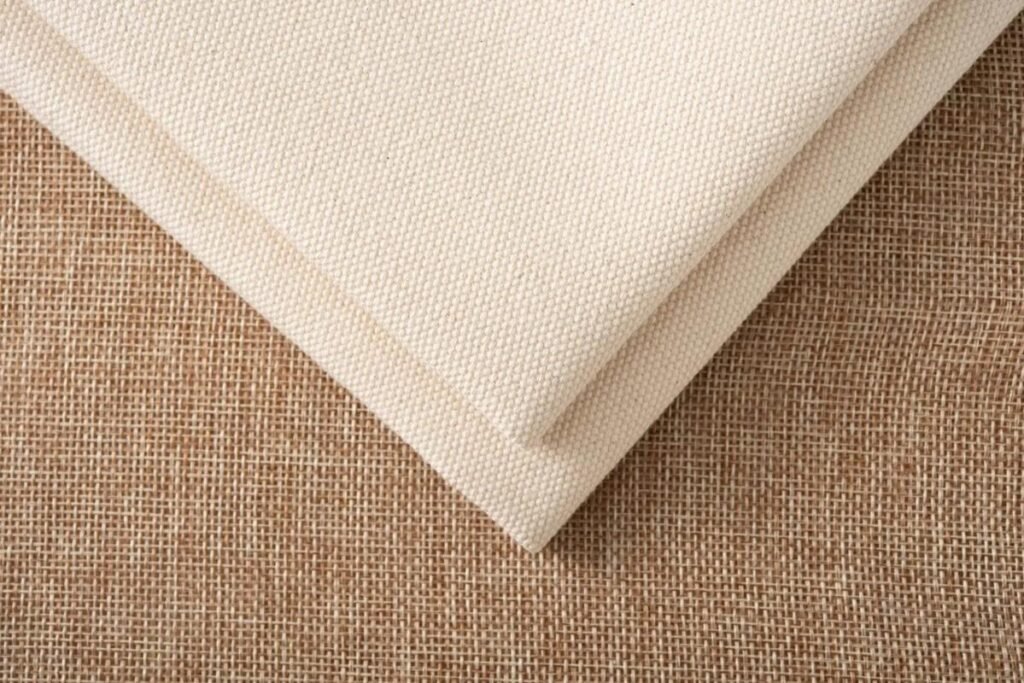
Today’s canvas mills lean heavily on three main fiber categories: cotton, polyester, and blended yarns. Cotton remains popular for its soft hand, dye affinity, and breathability, making it a top choice for art canvases, upholstery, and lightweight awnings. Polyester offers superior abrasion resistance, UV stability, and low moisture regain, ideal for outdoor, marine, and industrial covers. Blended canvases—typically cotton–polyester or cotton–acrylic—strike a balanced performance, combining cotton’s comfort with polyester’s durability in mid-weight applications like tote bags, tents, and protective drapes.
Fiber Selection and Performance Trade-Offs
A. 100% Cotton Canvas
- Attributes: Breathability, natural hand, excellent dye uptake.
- Limitations: Prone to mildew, lower tensile strength (≈500 N tear), and greater shrinkage (3–5%).
- Use Cases: Fine art, indoor upholstery, fashion totes.
B. 100% Polyester Canvas
- Attributes: High tensile strength (800–1,200 N tear), UV resistance, minimal stretch (<1% shrink).
- Limitations: Stiffer hand, lower dye vibrancy without specialized pigments.
- Use Cases: Marine covers, industrial tarps, outdoor awnings.
C. Cotton–Polyester Blends
- Composition: 65/35 or 50/50 cotton/poly ratios are most common.
- Advantages: Improved strength (+20% over cotton), moderate breathability, reduced shrinkage (1–2%).
- Applications: Workwear, event tents, mixed-use upholstery.
D. Specialty Blends and Technical Fibers
- Examples: Cotton–acrylic for colorfastness; polyester–aramid for flame resistance; recycled PET for sustainability.
- Impact: Tailors canvas to niche demands—fire blankets, eco-friendly covers, or high-heat insulation.
Modern Canvas Fiber Comparison
| Fiber Type | Tear Strength (N) | Shrinkage (%) | UV Stability (hrs to 10% loss) | Moisture Regain (%) | Typical Weight (oz/yd²) |
|---|---|---|---|---|---|
| 100% Cotton | 400–600 | 3–5 | 200–300 | 8.5 | 10–14 |
| 100% Polyester | 800–1,200 | <1 | 1,000–1,500 | 0.4 | 12–18 |
| 65/35 Cotton–Polyester | 600–800 | 1–2 | 500–700 | 4.5 | 12–16 |
| Polyester–Aramid | 1,200–1,500 | <1 | 2,000+ | 0.4 | 14–20 |
| Recycled PET Canvas | 700–900 | <1 | 800–1,200 | 0.5 | 12–18 |
Critical Perspectives
- Natural vs. Synthetic Sustainability Cotton is biodegradable but water-intensive; polyester demands less water but is petroleum-based—blends complicate recycling at end-of-life.
- Strength vs. Comfort High-tenacity synthetics excel in durability but sacrifice the soft hand that cotton users love—blends offer a middle ground, yet will never fully match pure cotton’s feel.
- Colorfastness and Dye Chemistry Polyester requires disperse dyes and higher temperatures, increasing energy use; cotton is compatible with reactive dyes but suffers more UV fade outdoors.
- Cost Considerations Synthetic canvases often cost 10–15% more upfront but deliver longer service life in harsh conditions, yielding lower lifecycle costs.
How Does Cotton Canvas Differ from Polyester Canvas in Strength and Durability?
Cotton and polyester canvases serve distinct purposes because of their fiber properties. Cotton canvas offers a softer hand and excellent breathability, with tear strengths around 400–600 N and moderate abrasion resistance—perfect for art, indoor upholstery, and fashion applications. In contrast, polyester canvas delivers tear strengths up to 1,200 N, UV stability exceeding 1,000 hours, and virtually zero shrinkage, making it the go-to for outdoor, marine, and industrial covers. Understanding these differences helps manufacturers and end users choose the right fabric for their performance needs.
Cotton vs. Polyester Canvas Performance
A. Tear and Tensile Strength
Cotton Canvas:
- Tear Strength: 400–600 N (ASTM D2261)
- Tensile Strength: 2,000–2,500 N (ASTM D5034)
Polyester Canvas:
- Tear Strength: 800–1,200 N (ASTM D2261)
- Tensile Strength: 3,000–4,000 N (ASTM D5034)
B. Abrasion and Pilling Resistance
- Cotton Canvas: Up to 20,000 rubs (Martindale) before visible wear; prone to pilling over time
- Polyester Canvas: Over 50,000 rubs; low pilling and maintains surface integrity under heavy traffic
C. UV Stability and Weathering
- Cotton Canvas: Color fade begins after 200–300 hours of direct UV exposure; fibers weaken by 15% at 500 hours
- Polyester Canvas: Retains >90% tensile strength after 1,000 hours; UV inhibitors can extend this to 2,000 hours
D. Dimensional Stability and Moisture Behavior
- Cotton Canvas: Shrinkage of 3–5% on first laundering; moisture regain around 8.5%, which can lead to mildew
- Polyester Canvas: Shrinkage <1%; moisture regain <0.5%, ensuring rapid drying and resistance to rot
E. Hand Feel and Dyeing
- Cotton Canvas: Soft, breathable, dye affinity for reactive and pigment dyes, resulting in rich colors
- Polyester Canvas: Slightly stiffer, requires disperse dyes at higher temperatures, can appear less vibrant without special finishes
Cotton vs. Polyester Canvas Metrics
| Property | Cotton Canvas | Polyester Canvas |
|---|---|---|
| Tear Strength (N) | 400–600 | 800–1,200 |
| Tensile Strength (N) | 2,000–2,500 | 3,000–4,000 |
| Abrasion Resistance (rubs) | 20,000 | 50,000+ |
| UV Stability (hrs to 10% loss) | 200–300 | 1,000–2,000 |
| Shrinkage (%) | 3–5 | <1 |
| Moisture Regain (%) | 8.5 | 0.4 |
| Hand Feel | Soft, natural | Slightly firm |
| Dye Process | Reactive/pigment | Disperse/high-temp |
Critical Perspectives
- Durability vs. Comfort Trade-Off Polyester’s clear strength advantages come at the cost of a stiffer hand. Blends aim to bridge this gap but can never fully replicate pure cotton’s natural feel.
- Long-Term Outdoor Performance While cotton can be treated for UV and mildew resistance, these finishes wash out faster than intrinsic polyester UV stability—plan for more frequent re-treatment or replacement.
- Environmental Impacts Cotton cultivation is water- and pesticide-intensive, whereas polyester is petroleum-based. Balancing lifecycle environmental costs is key when selecting between them.
- Cost and Lifecycle Analysis Polyester canvas typically costs 10–20% more per yard but can last 2–3 times longer in outdoor conditions—yielding lower total ownership costs over time.
What Benefits Do Cotton–Polyester Blends Bring to Industrial and Commercial Canvas?
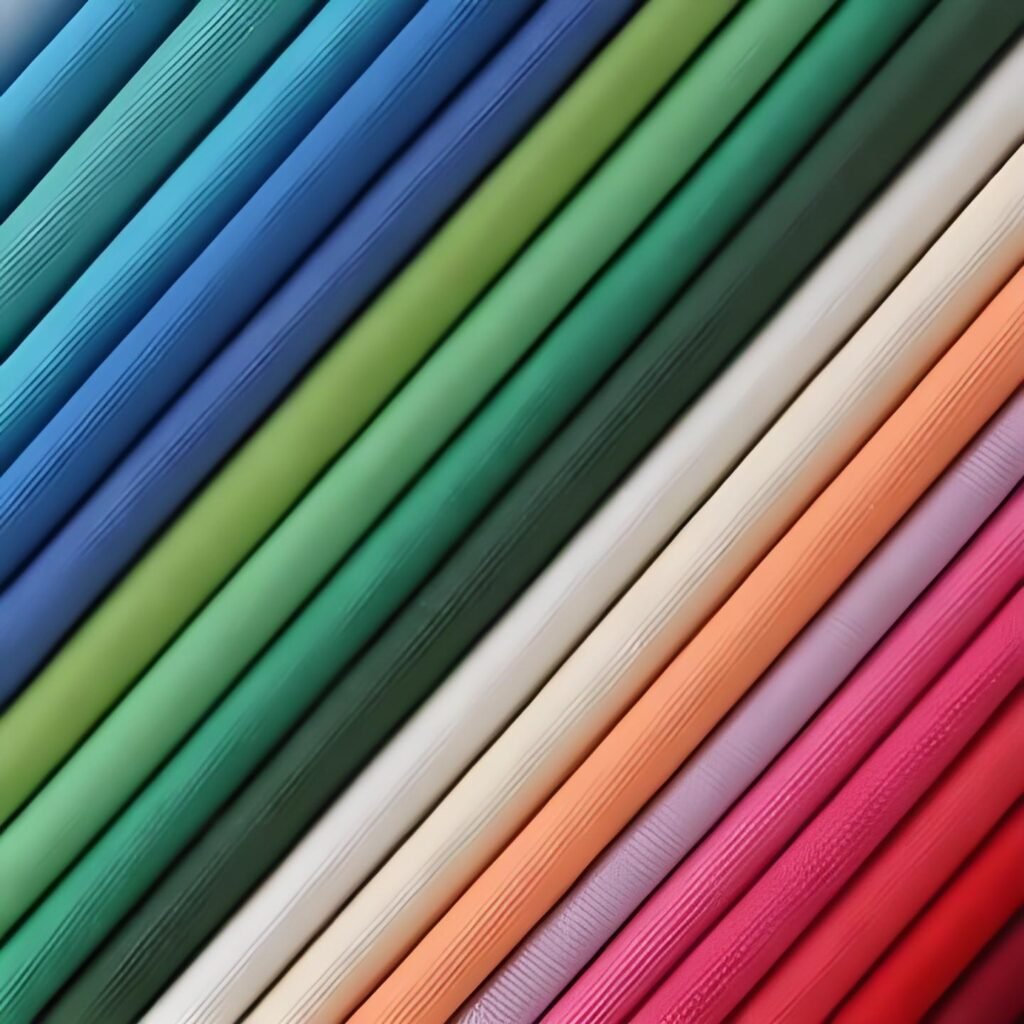
Cotton–polyester blended canvases merge the best of both worlds: they combine cotton’s softness and dye vibrancy with polyester’s dimensional stability and UV resilience, resulting in a fabric that is both comfortable and long-lasting. Blends typically exhibit 20–30% higher tear strength than pure cotton, shrink less than 2%, and resist fading for 500–700 hours of UV exposure—making them perfect for mid-weight applications like event tents, workwear, and mixed-use upholstery where appearance and performance both matter.
Blend Ratios, Performance Trade-Offs, and Use Cases
A. Common Blend Ratios
65/35 Cotton/Polyester:
- Characteristics: 65% cotton gives a soft hand and rich dye uptake; 35% polyester provides strength and reduced shrinkage.
- Ideal For: Canvas tote bags, indoor-outdoor upholstery, and light-duty industrial aprons.
50/50 Cotton/Polyester:
- Characteristics: Balanced properties—breathability and durability in equal measure.
- Ideal For: Event tents, café awnings, and canvas banners where both color and longevity are crucial.
B. Mechanical and Dimensional Properties
Tear Strength:
- 65/35 blends: 600–800 N (15–25% above cotton)
- 50/50 blends: 700–900 N (20–40% above cotton)
Shrinkage:
- 65/35: 1.5–2% vs. 3–5% cotton
- 50/50: 1–1.5% vs. <1% for polyester
C. UV and Abrasion Resistance
UV Stability:
- 65/35: 500–700 hours to 10% tensile loss
- 50/50: 700–900 hours to 10% tensile loss
Abrasion:
- Blends withstand 30,000–40,000 rubs (Martindale) vs. cotton’s 20,000 and polyester’s 50,000.
D. Dyeing and Finish Considerations
- Dye Uniformity: Blends require combined reactive/disperse dye processes; yield vibrant tones with minimal metamerism.
- Finishes: Can accept water-repellent, flame-retardant, or antimicrobial treatments effectively, balancing add-on polarities.
Cotton, Polyester, and Blend Canvas Comparison
| Property | 100% Cotton | 65/35 Blend | 50/50 Blend | 100% Polyester |
|---|---|---|---|---|
| Tear Strength (N) | 400–600 | 600–800 | 700–900 | 800–1,200 |
| Shrinkage (%) | 3–5 | 1.5–2 | 1–1.5 | <1 |
| UV Stability (hrs) | 200–300 | 500–700 | 700–900 | 1,000–1,500 |
| Abrasion (rubs) | 20,000 | 30,000–35,000 | 35,000–40,000 | 50,000+ |
| Moisture Regain (%) | 8.5 | 5.5 | 4.5 | 0.4 |
| Hand Feel | Soft | Moderately Soft | Moderate | Firm |
Critical Perspectives
- Blend Ratio Optimization Choosing 65/35 vs. 50/50 depends on whether a softer feel (more cotton) or greater durability (more polyester) is prioritized. Custom ratios (e.g., 80/20) can further fine-tune properties.
- Dye Process Complexity Dual‐dye processes increase production steps and costs by \~10%, but ensure consistent color matching across batches.
- End-of-Life Recycling Blended fabrics complicate recycling; look for take-back programs that separate fibers or consider chemical recycling solutions.
- Cost vs. Lifecycle Value Blends cost \~5–10% more than pure cotton, yet often outlast cotton by 2× in mixed-use scenarios, yielding better long-term ROI.
How Are Raw Canvas Fibers Processed into Finished Fabric on the Factory Floor?
Transforming raw fibers—cotton bales or polyester chips—into sturdy canvas involves a multi-stage workflow: spinning, weaving, scouring, bleaching or dyeing, and finishing. Each step demands precise control to yield consistent weave density, colorfastness, and surface performance. Modern mills leverage automated looms, real-time tension sensors, and eco-friendly finishing baths to maintain tight tolerances—ensuring every yard of canvas meets industrial-grade specifications.
Key Manufacturing Stages and Quality Controls
A. Fiber Preparation and Spinning
- Process:
- Opening & Cleaning: Remove impurities from cotton bales or PET flakes.
- Carding & Drawing: Align fibers, form slivers with uniform thickness.
- Spinning: Twist slivers into yarn—100–200 Tex thickness for canvas warp and weft.
- Quality Check: Automated thread count meters detect yarn diameter variances above ±2%.
B. Weaving on Rapier or Air-Jet Looms
- Technique:
- Warping: Wind warp yarns onto beams with precise tension (10–15 N).
- Weaving: Shuttleless rapier looms interlace weft at 200–300 picks per minute, achieving 8–12 threads per cm.
- Data: Modern looms maintain warp and weft tensions within ±5 % to prevent density fluctuations.
C. Scouring, Bleaching, and Dyeing
- Scouring: Removes oils and sizing agents in 90 °C alkaline baths.
- Bleaching: Hydrogen peroxide brightens cotton; dispersion dyes attach to polyester at 130–140 °C.
- Quality Control: Spectrophotometers verify ΔE color variance ≤ 1.0 between batches.
D. Finishing Treatments
Options:
- Calendering: Smooths surface via heated rollers—enhances hand feel.
- Coating: Adds water-repellent, flame-retardant, or antimicrobial layers.
- Inspection: Tensile and peel tests confirm coating adhesion ≥ 10 N/cm.
E. Cutting, Inspection, and Packaging
- Final Steps: Canvas fabrics are slit into rolls, visually inspected for flaws (<0.5 % defect rate), labeled with lot numbers, and shrink-wrapped for shipment.
Factory Processing Metrics
| Stage | Key Parameters | Tolerance/Metric | QC Method |
|---|---|---|---|
| Spinning | Yarn count (100–200 Tex) | ±2 % diameter variance | Optical yarn gauges |
| Weaving | Picks/minute (200–300) | ±5 % tension consistency | Load cell sensors |
| Scouring/Bleaching | Bath temp (90 °C), pH (9–10) | Residual oil <0.5 % | Gravimetric analysis |
| Dyeing | Temp (130–140 °C), dyebath time (45 min) | ΔE color variance ≤ 1.0 | Spectrophotometry |
| Coating | Add-on weight (20–50 g/m²) | Peel strength ≥ 10 N/cm | Peel adhesion tests |
Critical Perspectives
- Automation vs. Hand-Crafted Quality Automated looms ensure uniformity but lack the artisanal variations prized in bespoke art canvases—some mills retain small handloom sections for premium products.
- Energy and Water Use High-temperature dyeing of polyester consumes significant energy, whereas cold-pad batch dyeing offers up to 30 % savings but requires longer soak times.
- Chemical Management and Sustainability Closed-loop scouring and bleaching systems reduce effluent by 60 %; selecting low-impact chemicals aligns with environmental regulations and customer ESG goals.
- Traceability and Batch Consistency Implementing RFID tags on fabric rolls enables end-to-end traceability—vital for high-end upholstery and safety-critical applications.
Do Natural and Synthetic Canvases Vary in Environmental Impact and Sustainability?
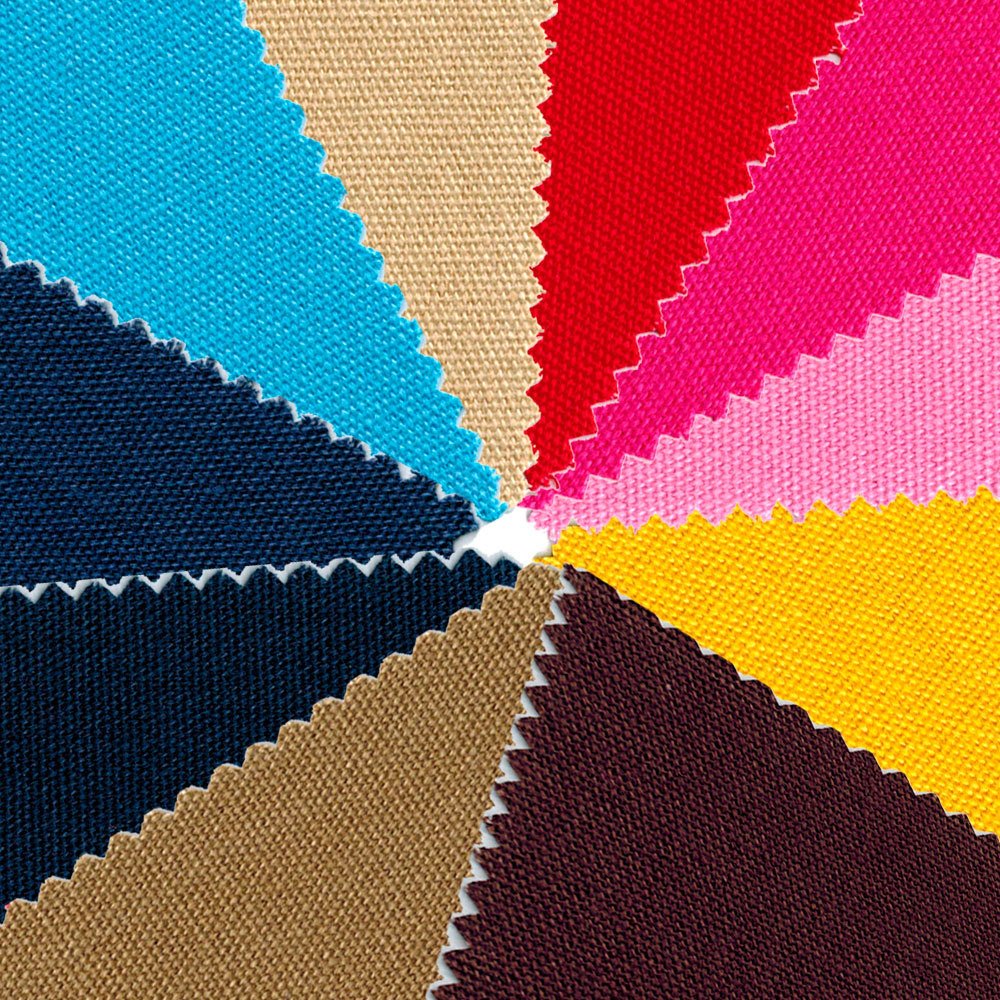
Increasingly, businesses demand fabrics that not only perform but also align with sustainability goals. Natural canvases—primarily cotton—are biodegradable and renewable but consume significant water (˜10,000 L/kg) and often rely on pesticides. Synthetic canvases like polyester use less water and resist mildew but derive from petroleum and resist biodegradation. Blends introduce recycling challenges. Balancing lifecycle impacts—water use, carbon footprint, recyclability—is key to making eco-conscious fabric choices.
Lifecycle Analysis and Sustainability Metrics
A. Water Footprint
- Cotton: 10,000–20,000 L per kg of fiber (including irrigation)
- Polyester: 100–200 L per kg (mainly processing)
- Blend: Weighted average based on blend ratio
B. Carbon Emissions
- Cotton: 1.5–2.0 kg CO₂e per kg (farming + processing)
- Polyester: 5.5–6.5 kg CO₂e per kg (oil extraction + polymerization)
- Recycled PET: 1.0–1.5 kg CO₂e per kg (recycling feedstock)
C. End-of-Life and Recyclability
- Cotton: Biodegrades in 2–5 years in landfill; compostable
- Polyester: Persists > 200 years; can be mechanically or chemically recycled
- Blends: Difficult to separate; limited recycling streams
D. Chemical Use and Pollution
- Cotton: High pesticide and fertilizer load—16% of global insecticides
- Polyester: Low agricultural chemicals but microplastic shedding during washes
- Mitigation: Organic cotton, closed-loop dyeing, microplastic filters
Sustainability Comparison of Canvas Types
| Metric | 100% Cotton | 100% Polyester | Recycled Polyester | Blends (65/35) |
|---|---|---|---|---|
| Water Use (L/kg) | 10,000–20,000 | 100–200 | 200–300 | 6,500–12,500 |
| Carbon Emissions (kg CO₂e/kg) | 1.5–2.0 | 5.5–6.5 | 1.0–1.5 | 3.0–4.0 |
| Biodegradability | Yes (2–5 yrs) | No | No | Partial |
| Recyclability | High | High | Very High | Low–Medium |
| Chemical Input | High (pesticides) | Low (processing) | Low (reprocessing) | Moderate |
Critical Perspectives
- Water vs. Carbon Trade-Off Cotton’s heavy water use can strain arid regions, while polyester’s carbon cost is higher—choosing between them depends on local resource priorities.
- Recycled Polyester’s Role Recycled PET dramatically cuts emissions and waste but still sheds microfibers—invest in wastewater filtration to mitigate microplastic pollution.
- Organic and Regenerative Agriculture Organic cotton reduces chemical runoff but may yield 20–30% less fiber per hectare. Regenerative practices promise higher soil health but need wider adoption and certification.
- Blends and Circularity Blends offer performance benefits but compromise recyclability. Innovations in fiber separation and chemical recycling are emerging but not yet mainstream.
Which Chemical Treatments and Coatings Enhance Canvas Performance?
Canvas’s natural strength can be tailored through a range of chemical finishes that boost water repellency, flame resistance, microbial protection, and UV stability. For example, silicone impregnation creates a hydrophobic network repelling over 3,000 mm of water head, while C6 fluorocarbon DWR causes water and oil to bead on the surface, maintaining breathability. Fire-retardant treatments (e.g., phosphorus-based or halogen-free systems) can achieve vertical burn ratings (ASTM D6413) with after-flame times under 2 seconds. These finishes transform basic canvas into multi-functional industrial materials, from marine covers to safety curtains.
Comparative Analysis of Canvas Finishes
A. Silicone Impregnation
- Function: Penetrates fibers to form a durable hydrophobic barrier.
- Performance: Waterhead ≥3,500 mm; retains ≥90% tensile strength after 2,000 hrs UV.
- Use Cases: Marine upholstery, chemical-resistant drapes, and high-heat insulation wraps.
B. Fluorocarbon Durable Water Repellent (DWR)
- Mechanism: Short-chain C6 fluoropolymers bond to yarn surfaces, repelling oils & water.
- Metric: ≥25° contact angle for water droplets; oil repellency grade ≥3 (AATCC 118).
- Applications: Industrial uniforms, spill containment tarps, and outdoor event shelters.
C. Fire-Retardant Treatments
- Chemistry: Non-halogenated phosphorus systems applied at 15–20 g/m².
- Results: Passes vertical burn (ASTM D6413) with after-flame <2 s and char length <50 mm.
- Scenarios: Welding curtains, stage backdrops, and facility safety drapes.
D. Anti-Microbial and Anti-Mildew Finishes
- Active Agents: Silver-ion or quaternary ammonium compounds bound via durable crosslinkers.
- Effectiveness: >95% bacterial reduction (AATCC 100) maintained through 50 home launderings.
- Ideal For: HVAC filters, food-processing covers, and humid-storage wraps.
E. UV-Stabilizing Coatings
- Components: Hindered amine light stabilizers (HALS) plus UV absorbers (benzotriazoles) at 2–3%.
- Impact: Extends color retention to 2,000–2,500 hrs QUV exposure, cutting tensile loss to <10%.
- Uses: Awnings, shade sails, and outdoor signage.
Performance of Common Canvas Chemical Finishes
| Finish Type | Key Benefit | Typical Add-On (g/m²) | Measured Performance |
|---|---|---|---|
| Silicone Impregnation | Hydrophobic barrier | 20–30 | 3,500 mm waterhead; UV retention ≥90% @2,000 h |
| Fluorocarbon DWR | Oil & water repellency | 15–25 | 25° water contact; oil repellency grade ≥3 |
| Fire-Retardant (Phosphorus) | Flame resistance | 15–20 | After-flame <2 s; char <50 mm |
| Anti-Microbial/Mildew | Biological growth inhibition | 5–10 | >95% reduction through 50 washes |
| UV-Stabilizing (HALS+UV Abs) | Extended outdoor durability | 20–30 | <10% tensile loss @2,500 h |
Critical Perspectives
- Durability vs. Breathability High add-on loads can impair canvas breathability—critical in applications like HVAC filters. Optimize finish weight to balance performance and airflow.
- Environmental Considerations Fluorocarbon finishes, even C6, raise ecological concerns; seek PFAS-free alternatives or third-party Ecolabel certifications.
- Maintenance and Reapplication Some treatments (e.g., DWR) degrade over time—establish re-treatment schedules (every 12–18 months) to sustain performance.
- Compatibility of Multi-Functional Finishes Layering finishes (e.g., fire-retardant plus DWR) can cause migration or adhesion issues—pilot test combined systems for adhesion (peel tests ≥10 N/cm) and efficacy.
Are There Emerging Innovations and Alternative Fibers in Canvas Manufacturing?
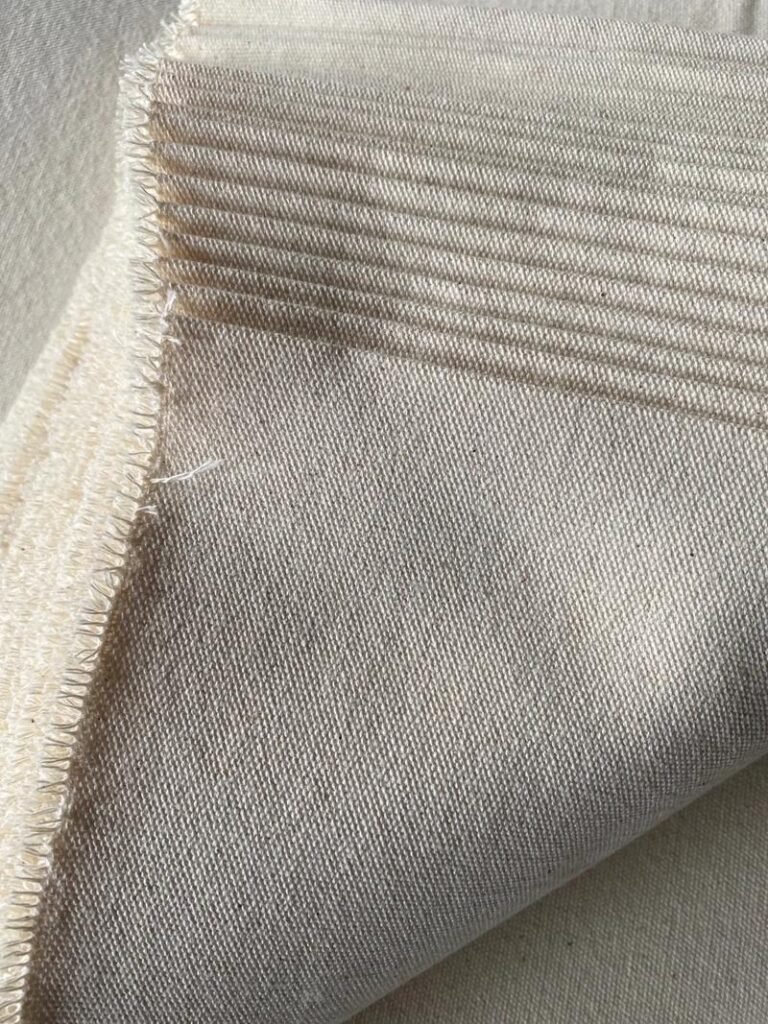
The canvas of tomorrow is evolving beyond traditional cotton and polyester, embracing high-performance and sustainable alternatives. Manufacturers now experiment with bio-based fibers like PLA (polylactic acid) and bamboo, high-strength synthetics such as UHMWPE (ultra-high-molecular-weight polyethylene), and smart textiles integrating conductive yarns. These innovations aim to reduce environmental impact, boost technical performance, and open new application frontiers—from self-cleaning awnings to impact-resistant shelters.
Next-Gen Canvas Materials and Technologies
A. Biodegradable and Bio-Based Fibers
- PLA Canvas: Made from fermented corn starch, PLA offers cotton-like hand, biodegrades in industrial compost within 12 months, and requires 50% less water than cotton.
- Bamboo Canvas: Bamboo viscose fibers provide natural antibacterial properties, 2× the moisture wicking of cotton, and regrow with minimal agrochemical inputs.
B. High-Strength Technical Fibers
- UHMWPE Canvas: Exhibits tensile strengths up to 3,500 N, 8× that of cotton, and boasts excellent chemical resistance—ideal for ballistic panels and high-load slings.
- Aramid Blends: Canvas woven with aramid (e.g., Kevlar®) achieves cut resistance (ANSI A9) and heat stability up to 300 °C for flameproof curtains and rescue gear.
C. Smart and Functional Textiles
- Conductive Yarns: Silver- or carbon-coated threads woven into canvas enable touchscreen compatibility and embedded heating elements, useful in tents for extreme climates.
- Photo-Catalytic Coatings: TiO₂ nanoparticle finishes break down organic pollutants and self-clean the surface under UV light—ideal for outdoor signage and pollution-prone areas.
D. Advanced Recycling and Circular Models
- Chemical Recycling: Solvent-based processes separate blended fibers into pure streams—up to 90% recovery rates in pilot projects.
- Closed-Loop Manufacturing: Some mills collect end-of-life canvas from clients to regenerate new yarn, slashing virgin material use by 30%.
Cutting-Edge Canvas Fiber Innovations
| Innovation | Key Property | Environmental Impact | Current Application |
|---|---|---|---|
| PLA Canvas | Biodegradable (12 mo) | Low water, low carbon | Eco-friendly tents, art canvases |
| Bamboo Viscose Canvas | Natural antibacterial, wicking | Low agrochemical use | Medical drapes, hygiene covers |
| UHMWPE Canvas | Ultra-high tensile strength | Non-biodegradable | Ballistic panels, heavy slings |
| Aramid–Canvas Blends | Heat & cut resistance | Difficult recycling | Firefighting gear, welding pads |
| Conductive Canvas | Electronic integration | Varies by coating | Smart tents, heated shelters |
| Photo-Catalytic Coating | Self-cleaning, pollutant breakdown | Low maintenance | Pollution control covers |
Critical Perspectives
- Performance vs. Scalability Many advanced fibers remain costly and limited in production scale. Widespread adoption depends on economies of scale and supply-chain maturity.
- Regulatory and Safety Hurdles New fibers (e.g., PLA, nanocoatings) require rigorous testing for flame retardancy, mechanical safety, and human-health impact before industrial certification.
- Life-Cycle Trade-Offs Biodegradable canvases excel in end-of-life but may underperform in longevity. Conversely, high-performance synthetics endure but contribute to microplastic pollution without proper recycling.
- Integration with Traditional Processes Adapting legacy machinery for new materials involves retooling costs and specialized training—planning pilot runs and gradual scale-up is essential.
Ready to explore custom canvas solutions?
From hemp and flax sails of old to tomorrow’s smart, self-cleaning canvases, the evolution of canvas fibers reflects both technological innovation and shifting sustainability priorities. Whether you require classic 100% cotton for fine art, rugged polyester for marine covers, balanced blends for event tents, or cutting-edge UHMWPE for high-strength applications, understanding these fiber choices empowers you to specify the perfect canvas for your project.
At Szoneier Fabrics, we offer:
- Tailored fiber selections—from organic cotton to technical blends
- Specialized finishes like DWR, flame retardants, and nano-coatings
- Low-MOQ prototyping, rapid sample delivery, and guaranteed quality
- Support for eco-conscious manufacturing, including recycled and bio-based options
Get in touch today to request free samples, discuss your application requirements, and receive a competitive quote. Let Szoneier Fabrics be your partner in crafting the next generation of canvas products!

